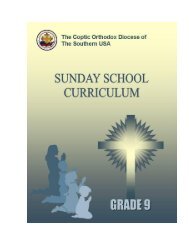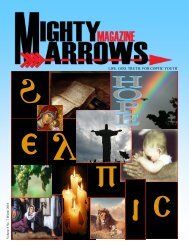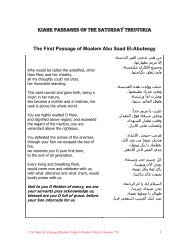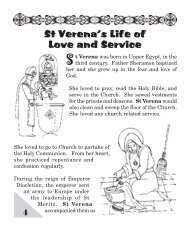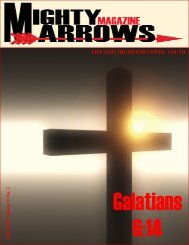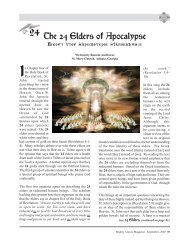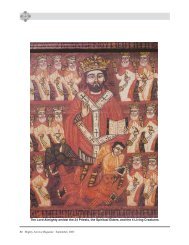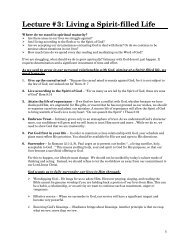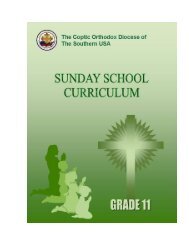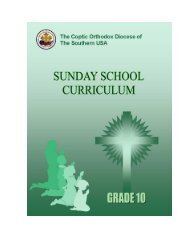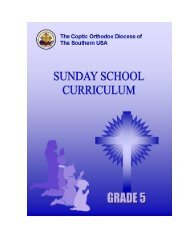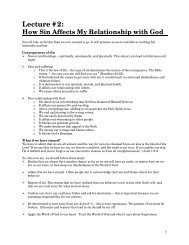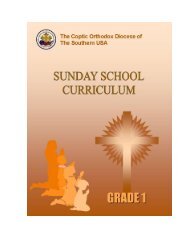Grade 12 - Coptic Orthodox Diocese of the Southern United States
Grade 12 - Coptic Orthodox Diocese of the Southern United States
Grade 12 - Coptic Orthodox Diocese of the Southern United States
Create successful ePaper yourself
Turn your PDF publications into a flip-book with our unique Google optimized e-Paper software.
Sunday School Curriculum <strong>Grade</strong> <strong>12</strong><br />
St. Jerome informs us about an abbot called Apollo who was always smiling. He attracted many to<br />
<strong>the</strong> ascetic life as a source <strong>of</strong> inward joy and heartfelt satisfaction in our Lord Jesus. He <strong>of</strong>ten used to<br />
say, ―Why do we struggle with an unpleasant face? Aren‘t we <strong>the</strong> heirs <strong>of</strong> <strong>the</strong> eternal life? Leave <strong>the</strong><br />
unpleasant and <strong>the</strong> grieved faces to pagans, and weeping to <strong>the</strong> evildoers. But it befits <strong>the</strong> righteous<br />
and <strong>the</strong> saints to be joyful and pleasant since <strong>the</strong>y enjoy <strong>the</strong> spiritual gifts.‖<br />
This attitude is reflected upon church worship, her art and all her aspects <strong>of</strong> life, so that it seems<br />
that <strong>the</strong> church life is a continuous unceasing feast. Pope Athanasius <strong>the</strong> Apostolic tells us in one <strong>of</strong><br />
his paschal letters that ―Christ‖ is our feast. Although <strong>the</strong>re are perpetual Feasts, <strong>the</strong> believer<br />
discovers that his feast is in his innermost, i.e., in <strong>the</strong> dwelling <strong>of</strong> Christ <strong>the</strong> life-giving Lord in him.<br />
The church relates and joins <strong>the</strong> feasts to <strong>the</strong> ascetic life. The believers practice fasting, sometimes<br />
for almost two months (Great Fast) in preparation for <strong>the</strong> feast, in order to realize that <strong>the</strong>ir joy is<br />
based on <strong>the</strong>ir communion with God and not in eating, drinking and new clo<strong>the</strong>s.<br />
The <strong>Coptic</strong> feasts have deep and pleasant hymns, and splendid rites that inflame <strong>the</strong> spirit. Their<br />
aim is to <strong>of</strong>fer <strong>the</strong> living, heavenly and evangelic thought and to expose us to <strong>the</strong> Holy Trinity and<br />
<strong>the</strong>ir redeeming work in <strong>the</strong> life <strong>of</strong> <strong>the</strong> church, in a way that is simple enough to be experienced by<br />
children, and deep enough to quench <strong>the</strong> thirst <strong>of</strong> <strong>the</strong>ologians.<br />
III. Feasts <strong>of</strong> <strong>the</strong> <strong>Coptic</strong> Church<br />
A. The Seven Major Feasts <strong>of</strong> Our Lord<br />
1 The Annunciation on Paramhat 29, c. April 7: In it we recall <strong>the</strong> fulfillment <strong>of</strong> <strong>the</strong> Old<br />
Testament prophecies, and <strong>the</strong> attainment, which <strong>the</strong> men <strong>of</strong> God had longed for across <strong>the</strong><br />
ages, namely <strong>the</strong> coming <strong>of</strong> <strong>the</strong> Word <strong>of</strong> God incarnate in <strong>the</strong> Virgin‘s womb .<br />
2 The Nativity <strong>of</strong> Christ on Kiahk 29, c. January 7: It is preceded by a fast <strong>of</strong> 43 days. It is<br />
<strong>the</strong> confirmation <strong>of</strong> <strong>the</strong> divine love, when God sent His Only-begotten Son incarnate. Its aim<br />
is to prepare <strong>the</strong> hearts <strong>of</strong> <strong>the</strong> believers to receive Jesus Christ; <strong>the</strong> Word <strong>of</strong> <strong>the</strong> New<br />
Testament, in <strong>the</strong> same way Moses fasted in order to receive <strong>the</strong> Ten Commandments, <strong>the</strong><br />
Word <strong>of</strong> <strong>the</strong> Old Testament.<br />
3 The Epiphany or <strong>the</strong> Baptism <strong>of</strong> Christ on Tuba 11, c. January 19/20. It is connected with<br />
Nativity and <strong>the</strong> circumcision feasts for in <strong>the</strong> Nativity, <strong>the</strong> Word <strong>of</strong> God took what is ours<br />
(our humanity), and in <strong>the</strong> ―circumcision‖, He subjected Himself to <strong>the</strong> Law, as He became<br />
one <strong>of</strong> us. But in <strong>the</strong> Epiphany, He <strong>of</strong>fered us what is His own. By His incarnation, He<br />
became a true man while still being <strong>the</strong> Only-begotten Son <strong>of</strong> God, and by baptism we<br />
became children <strong>of</strong> God in Him while we are yet human beings. In this feast, <strong>the</strong> liturgy <strong>of</strong><br />
blessing <strong>the</strong> water is conducted, and <strong>the</strong> priest blesses <strong>the</strong> people by <strong>the</strong> water on <strong>the</strong>ir<br />
foreheads and hands to commemorate baptism.<br />
4 The Entry <strong>of</strong> Jesus into Jerusalem (Palm Sunday): It is <strong>the</strong> Sunday that precedes Easter. It<br />
has its characteristic joyful hymns (<strong>the</strong> Shannon -Hosanna (Mat<strong>the</strong>w 21:9)), and its delightful<br />
rite. The church commemorates <strong>the</strong> entrance <strong>of</strong> our Lord Jesus into our inward Jerusalem to<br />
establish His Kingdom in us and ga<strong>the</strong>r all in Him. A procession moves towards <strong>the</strong> nave <strong>of</strong><br />
<strong>the</strong> church were it stops before <strong>the</strong> icons <strong>of</strong> St. Mary, <strong>the</strong> Archangels, St. John <strong>the</strong> Baptist, <strong>the</strong><br />
Apostles, <strong>the</strong> martyrs, <strong>the</strong> ascetics, etc…and before <strong>the</strong> church doors and <strong>the</strong> baptismal basin,<br />
praising God who embraces all toge<strong>the</strong>r in His Son Jesus Christ. The procession ends by reentering<br />
<strong>the</strong> sanctuary <strong>of</strong> God as <strong>the</strong> saints <strong>of</strong> <strong>the</strong> Old and New testaments meet with <strong>the</strong><br />
heavenly in heaven (sanctuary) forever. At <strong>the</strong> end <strong>of</strong> <strong>the</strong> Liturgy <strong>of</strong> Eucharist, a general<br />
funeral service is held over water, which is sprinkled on everyone just in case anyone may<br />
158 PENTECOST PERIOD



